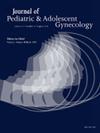41. 女高中生运动员的铁蛋白筛查确定了许多缺铁的人
IF 1.7
4区 医学
Q3 OBSTETRICS & GYNECOLOGY
引用次数: 0
摘要
背景:缺铁(ID)在青少年女性中非常普遍。它与注意力不集中和疲劳有关,并可能影响学业和运动成绩。在这项研究中,我们试图量化青少年女学生运动员的ID患病率,并将ID与疲劳、运动表现和学习成绩联系起来。方法对某郊区高中女学生运动员进行横断面调查。在IRB批准后,学生们在运动队训练期间被要求参加研究。在征得家长同意后,学生们进行了铁蛋白测试,并对疲劳、运动表现和学习成绩进行了评估。缺铁被定义为铁蛋白;30 ng / mL。结果慢铁蛋白(<;30 ng/mL), 8/23(35%)女学生运动员。只有两人事先意识到自己缺铁。疲劳、运动表现和学习成绩将在2025年NASPAG的报告中报告。结论在对女学生运动员的横断面研究中,我们发现缺铁是常见的。我们的发现,35%的人有低铁蛋白,这与Weyand等人在一项基于nhanes的大型横断面研究中发现的青少年女性缺铁的患病率是一致的。在我们的研究中,大多数患有铁缺乏症的学生事先并不知道自己缺铁。本研究强调了对女学生运动员进行缺铁筛查的重要性。更多的学生运动员筛选将在2025年NASPAG的报告中报告。本文章由计算机程序翻译,如有差异,请以英文原文为准。
41. Ferritin Screening in Female High School Student-Athletes Identifies Many who have Iron Deficiency
Background
Iron deficiency (ID) is highly prevalent among teenage females. It has been associated with impaired concentration and fatigue, and it may affect both academic and athletic performance. In this study, we sought to quantify the prevalence of ID in teenage female student-athletes, and to correlate ID with fatigue, athletic performance, and academic performance.
Methods
We conducted a cross-sectional study of female student-athletes in a suburban high school. After IRB approval, students were approached for study enrollment during a sports team practice session. After obtaining parental consent, students had ferritin testing and assessments of fatigue, athletic performance, and academic performance. Iron deficiency was defined as ferritin < 30 ng/mL.
Results
Low ferritin (< 30 ng/mL) was found in 8/23 (35%) female student-athletes. Only two had prior awareness that they had iron deficiency. Fatigue, athletic performance, and academic performance will be reported in a 2025 NASPAG presentation.
Conclusions
In this cross-sectional study of female student-athletes, we found that iron deficiency is common. Our finding, 35% with low ferritin, is consistent with the prevalence of iron deficiency among teenage females in a large NHANES-based cross-sectional study by Weyand, et al. Most of the students found to have ID in our study had no prior knowledge that they had iron deficiency. This study highlights the importance of iron deficiency screening in female student-athletes. More student-athlete screening will be reported in a 2025 NASPAG presentation.
求助全文
通过发布文献求助,成功后即可免费获取论文全文。
去求助
来源期刊
CiteScore
3.90
自引率
11.10%
发文量
251
审稿时长
57 days
期刊介绍:
Journal of Pediatric and Adolescent Gynecology includes all aspects of clinical and basic science research in pediatric and adolescent gynecology. The Journal draws on expertise from a variety of disciplines including pediatrics, obstetrics and gynecology, reproduction and gynecology, reproductive and pediatric endocrinology, genetics, and molecular biology.
The Journal of Pediatric and Adolescent Gynecology features original studies, review articles, book and literature reviews, letters to the editor, and communications in brief. It is an essential resource for the libraries of OB/GYN specialists, as well as pediatricians and primary care physicians.

 求助内容:
求助内容: 应助结果提醒方式:
应助结果提醒方式:


